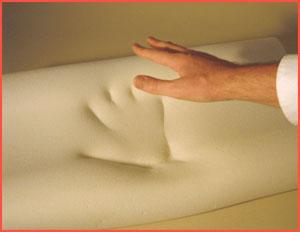
Knowing how to fix a sagging memory foam mattress can significantly extend the life of your mattress. Through time, a memory foam mattress can begin to sag, and once you notice this it will simply get worse and worse until it becomes too uncomfortable to sleep on. This is when you will look for some information on how to fix this without having to purchase a new mattress. Look no more, because here is how to fix a depression in a memory foam mattress explained in easy to follow steps. First, let's have a look at what causes a memory foam mattress to sag.
Tips to Fix a Sagging Memory Foam Mattress
What Causes a Memory Foam Mattress to Sag?
Before we explain how to fix a sagging memory foam mattress, let's first have a look at the most common reasons for the mattress sagging. This might enable you to delay, or even avoid, further mattress sagging once you have fixed it.
1. The mattress is old and has been used for a long time
The most common reason for a mattress sagging is the length of time it has been used. Most mattresses develop sagging or a depression in a specific area of the mattress if you sleep on that same area all the time. You can help prevent this, or at least extend the mattress's useful life by rotating it now and again or flipping it if this is possible. Not all mattresses can be flipped although most 100% memory foam mattresses can be.
Your mattress will still ultimately sag, but by changing the surface you use to sleep on, you can often extend the time it takes for sagging to develop. Most sagging in foam mattresses is due to disintegration of the inner part of the foam which reduces the support provided by the mattress.
2. Placing your mattress on an uneven surface
If the surface or base your mattress is lying on is uneven, then over time the mattress will conform to any depressions in the base or foundation. As we will explain below, removing the unevenness of the base will prevent this.
3. Presence of moisture
If there is any moisture present, the damp area of mattress will sag more than the dry area. There may already be moisture present where you place the mattress, or your body might sweat a lot during the night. The latter will accelerate sagging of the mattress in the area where you are lying, and this will ultimately become a permanent depression.
It is also important that you care for your mattress. Check it out now again with a visual examination, looking for any signs of wear or the beginnings of a depression in a memory foam mattress that does not come back to flat as a memory foam should. It is easier to fix a depression or indentation in a mattress if you catch it quick, rather than wait until it becomes uncomfortable. The following remedies may be used to fix both small and larger depressions, although the sooner you notice it the better.
How to Fix a Depression in a Memory Foam Mattress
There are several ways to fix sagging in a memory foam mattress. Which of these you use will depend on the extent of the depression and its cause. The first of these is simple, and can be used immediately until you have the equipment needed for something more permanent.
1. Lay the mattress on the floor
By laying the mattress on the floor, it will have a solid base to prevent further sagging. When you do this, you will find it more comfortable to place some small pillows beneath the depressed area of the mattress. That is usually towards the middle for a sagging mattress. This will help it to become more even as the memory foam restores itself and flattens out. If this works you can then try solution #2 below. If testing this method on the floor does not work, then there is little point in using this solution.
2. Use a board on the bed
If you have had success by sleeping on the floor for a while, then transfer the principle to your bed. You can do this by using some plywood or particle board aka chipboard). Chipboard has a smoother surface than plywood, though Medium Density Fiberboard (MDF) is stronger and more water-resistant than chipboard. If this fails to work, then:
3. Use a mattress pad or topper
Many people find a mattress topper or mattress pad to be effective in fixing a sagging memory foam mattress. A topper should make your mattress more even and comfortable to sleep on. Some think it a better solution than using a board below the mattress, but that will depend on the extent and depth of the sagging. Toppers and pads come in various thicknesses, though you will likely need one between 2" and 4" thick, depending on the extent of your sagging.
Check out our Best Mattress Topper Reviews here. They may be more expensive than plywood or MDF, but they can be used on any mattress on any foundation to help flatten out a sagging mattress, whether it is caused by the foundation, too much wear, or even dampness. If dampness is an issue, simply cover the mattress or the base of the bed with polythene and use the mattress topper over this to lie on.
4. Waterproof the mattress
As explained above, the presence of moisture is a common reason for a sagging memory foam mattress. Once you have applied one of the remedies above, you can prevent further depression in a memory foam mattress by wrapping the mattress in polythene. If preferred, lay the polythene, or any other waterproof material, over the mattress if the moisture is caused by your perspiration or other sources of dampness. Apply it under the mattress if the moisture is coming from below - although it would be more sensible to eliminate the source of the moisture if possible.
5. Use a mattress helper
If the above tips don't work for you, some believe that the ultimate solution for a sagging mattress is a mattress helper. This is a structure placed under the sagging part of the mattress. The mattress helper lifts up the sagging area and gives you a flat sleeping surface. This is a more expensive option than the others, although it does work well for seriously sagging mattresses. It comes with a 30-Day guarantee - get your money back if it doesn't work for you. You can get more details of the Mattress Helper here.
Summary: How to Fix a Sagging Memory Foam Mattress
Sleeping on a sagging mattress can lead to back pain and serious orthopedic issues. It is important to know how to fix a sagging memory foam mattress in order to enable you to sleep comfortably and pain free. Solution 5, the mattress helper, will be the most expensive but it won't break the bank. This should be your choice if the mattress has significant sagging. The other options for a sagging mattress are good for localized sagging or an indentation in a specific part of the mattress. However, should the sagging or damage be severe, and none of the above solutions work well, you would likely be best to buy a new memory foam mattress.

